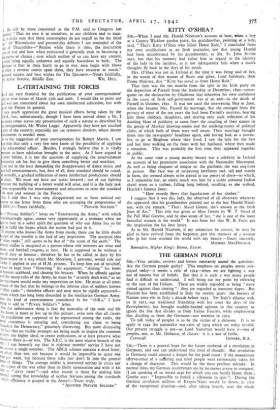• KITTY O'SHEA ?
SIR,—When I read Mr. Harold Nicolson's account of how, when a boy at a County Wicklow garden party, his grandmother, pointing at a lady, said, "That's Kitty O'Shea who killed Home Rule," I concluded from my own recollections as an Irish journalist, not that young Harold had been misinformed by his grandmother, as Mr. St. John Ervine says, but that his memory had fallen him in regard to the identity of the lady in the incident, as it not infrequently fails when a man's thoughts fly back to the days of his youth.
Mrs. O'Shea was not in Ireland at the time it was being said of her, in the words of that master of flouts and gibes, Lord Salisbury, then Prime Minister, that "Kitty has saved us from Home Rule."
That time was the ten months from the split in the Irish party on the deposition of Parnell from the leadership in December, 1890—conse- quent on the declaration by Gladstone that otherwise his own usefulness in the cause of Irish self-government was at an end—to the death of Parnell in October, 1891. It was not until the intervening May m June, when she became Mrs. Parnell by marriage, that she emerged from the privacy of most of the ten years she had been Parnell's mistress, bearing him three children, daughters, and sharing only such reflection of his dazzling blaze of publicity as came from the coupling of their names in the gossip of Mayfair drawing-rooms and the smoking-rooms of political clubs, of which both of them were well aware. Theis marriage brought them into the newspapers' headlines again, and having had, as a journa- list, to go to Brighton where they lived, I saw the lady for the first and last time walking on the front with her husband, where they made a sensation. This was probably the first time they appeared together in public.
At the same time a young society beauty was a celebrity in Ireland on account of her prominent association with the Nationalist Movement. As well as being eloquent of tongue OD the platform, she was exqoisite in person. Her face was of surpassing loveliness and, tall and stately in form, she seemed always to be attired in tne poetry of dress—to which, as I remember her, an exotic touch was lent by a richly coloured Indian shawl worn as a turban, falling long behind, recalling, as she walked, Herrick's famous lines:
"How sweetly flows that liquefaction of het clothes."
I suggest that it was this lady, the observed of all observers wherever she appeared, that his grandmother pointed out to the boy Harold Nicol- son, with the remark, "That's Maud Gonne, she's known as the Irish Joan of Arc." This title was given to Miss Gonne by W. T Stead of the Pall Mall Gazette, and he also wrote of her, "she is one of the most beautiful women in the world." It was from her that W. B. Yeats got the inspiration for his love lyrics.
As to Mr. Harold Nicolson, if my conjecture be correct, he may be glad to have revived from the forgotten past this memory of a woman who in her time witched the world with net beauty —Yours sincerely, MICHAEL MACDONAGH.
Bcrnnadon, Higher King's Burne, Exeter.


























 Previous page
Previous page